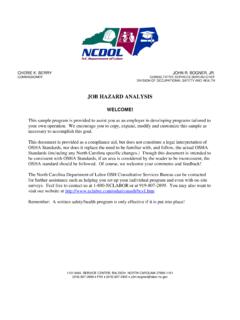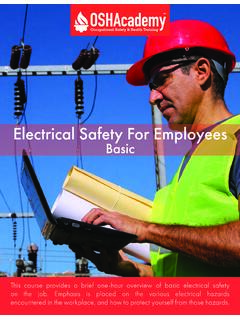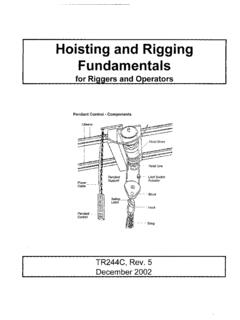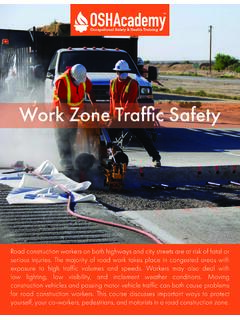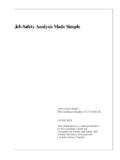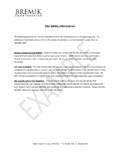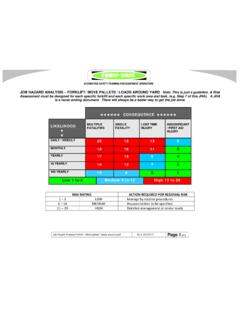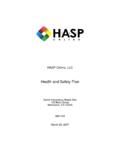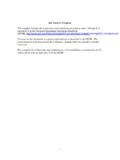Transcription of 706 Conducting a Job Hazard Analysis (JHA) - OSHA Train
1 If your company is working towards OSHA's SHARP or VPP certification, you need to be Conducting a Job Hazard Analysis (JHA) on all hazardous tasks. This course is designed to introduce the important steps in Conducting a Job Hazard Analysis (also called Job Safety Analysis ) for the purpose of writing a safe job procedure. This course includes a discussion of conductinga risk assessment, prioritizing jobs, writing the steps, determining hazards , including safety precautions, and tips on writing safe job a Job Hazard Analysis (JHA) This page intentionally blankOSHA cademy Course 706 Study Guide OSHA cademy Course 706 Study Guide Conducting a Job Hazard Analysis (JHA) Copyright 2019 Geigle Safety Group, Inc.
2 No portion of this text may be reprinted for other than personal use. Any commercial use of this document is strictly forbidden. Contact OSHA cademy to arrange for use as a training document. This study guide is designed to be reviewed off-line as a tool for preparation to successfully complete OSHA cademy Course 706. Read each module, answer the quiz questions, and submit the quiz questions online through the course webpage. You can print the post-quiz response screen which will contain the correct answers to the questions. The final exam will consist of questions developed from the course content and module quizzes. We hope you enjoy the course and if you have any questions, feel free to email or call: OSHA cademy 15520 NW Greenbrier Parkway, Suite 230 Beaverton, Oregon 97006 +1 (888) 668-9079 Disclaimer This document does not constitute legal advice.
3 Consult with your own company counsel for advice on compliance with all applicable state and federal regulations. Neither Geigle Safety Group, Inc., nor any of its employees, subcontractors, consultants, committees, or other assignees make any warranty or representation, either express or implied, with respect to the accuracy, completeness, or usefulness of the information contained herein, or assume any liability or responsibility for any use, or the results of such use, of any information or process disclosed in this publication. GEIGLE SAFETY GROUP, INC., DISCLAIMS ALL OTHER WARRANTIES EXPRESS OR IMPLIED INCLUDING, WITHOUT LIMITATION, ANY WARRANTIES OF MERCHANTABILITY OR FITNESS FOR A PARTICULAR PURPOSE. Taking actions suggested in this document does not guarantee that an employer, employee, operator or contractor will be in compliance with applicable regulations.
4 Ultimately every company is responsible for determining the applicability of the information in this document to its own operations. Each employer s safety management system will be different. Mapping safety and environmental management policies, procedures, or operations using this document does not guarantee compliance regulatory requirements. Revised: December 3, 2019 This page intentionally blankCourse 706 Contents Course Introduction .. 1 What is a Hazard ? .. 1 What is a job Hazard Analysis ? .. 1 Why is job Hazard Analysis important? .. 1 What is the value of a job Hazard Analysis ? .. 1 Module 1: Prepare to Conduct the JHA .. 2 Introduction .. 2 Involve Your Employees .. 2 The JHA Format .. 2 Sample JHA worksheet .. 3 Employees are Prone to Use Their "Own" Procedures When Not Being Supervised.
5 3 Look for Hazardous Conditions and Unsafe Behaviors .. 3 hazards .. 4 Behaviors .. 4 Review Incident/Accident History .. 5 Conduct a Risk Analysis .. 5 Risk = Probability x Severity x 6 Probability .. 6 Severity .. 6 Exposure .. 7 Factors that Increase Risk .. 7 The Risk Assessment Matrix .. 8 Crunch the Numbers .. 9 Course 706 Risk = Probability (6) x Severity (50) x Exposure (2) = 600 .. 9 Prioritize Jobs - Worst First .. 10 Module 2: List the Procedure Steps .. 12 Introduction .. 12 One Step - One Action .. 12 The Actor and the Action .. 12 Tips on Conducting the JHA .. 13 The JHA Format .. 14 Sample JHA worksheet .. 14 Module 3: Describe the hazards in Each Step .. 16 Introduction .. 16 How to Identify hazards .. 16 Scenario .. 17 Don't Forget Potential hazards .
6 18 Common hazards and Descriptions .. 19 Electrical (Shock/Short Circuit): .. 19 Electrical (Fire): .. 19 Electrical (Static/ESD):.. 20 Electrical (Loss of Power): .. 20 Module 4: Develop Preventive Measures .. 23 Introduction .. 23 Hazard Control Strategies .. 23 Hierarchy of Controls .. 23 Elimination and Substitution .. 24 Course 706 Engineering Controls .. 25 Warnings .. 25 Administrative Controls .. 26 Personal Protective Equipment .. 27 Interim Measures .. 27 Involve Employees .. 28 Sample JHA worksheet .. 28 Module 5: Write the Safe Job Procedure (SJP) .. 30 Introduction .. 30 Points to Remember .. 30 Sample JHA worksheet .. 32 Module 6: Improve the JHA Process .. 34 Introduction .. 34 When is it Appropriate to Hire a Professional to Conduct a Job Hazard Analysis ?
7 34 Tips to Improve the JHA .. 35 Improve the JHA Process by Taking a Team Approach .. 36 Team Responsibilities .. 36 This page intentionally blankCourse 706 Copyright 2015 Geigle Safety Group, Inc. Page 1 of 37 Course Introduction This online course explains what a job Hazard Analysis (JHA) is and offers guidelines to help you conduct your own step-by-step Analysis . The course also will also help you take the information from a JHA to write a safe job procedure (SJP) that can be used for training employees. What is a Hazard ? A Hazard is the potential for harm. In practical terms, a Hazard often is associated with a condition or activity that, if left uncontrolled, can result in an injury or illness. What is a job Hazard Analysis ?
8 A job Hazard Analysis is a technique that focuses on job tasks as a way to identify hazards before they occur. It focuses on the relationship between the worker, the task, the tools, and the work environment. Ideally, after you identify uncontrolled hazards , you will take steps to eliminate or reduce them to an acceptable risk level. Why is job Hazard Analysis important? Many workers are injured and killed at the workplace every day. Safety and health can add value to your business, your job, and your life. You can help prevent workplace injuries and illnesses by looking at your workplace operations, establishing safe job procedures, and ensuring that all employees are trained properly. What is the value of a job Hazard Analysis ? Supervisors can use the findings of a job Hazard Analysis to eliminate and prevent hazards in their workplaces.
9 This is likely to result in fewer worker injuries and illnesses; safer, more effective work methods; reduced workers' compensation costs; and increased worker productivity. The Analysis also can be a valuable tool for training new employees in the steps required to perform their jobs safely. This course introduces you to the Job Hazard Analysis process and also touches on how you can use it as a valuable tool for training. Course 706 Copyright 2015 Geigle Safety Group, Inc. Page 2 of 37 Module 1: Prepare to Conduct the JHA Introduction The first step in preparing to conduct a JHA is to review all of the jobs in the workplace and make a list of those jobs that might require a JHA. Involve Your Employees Get together with your employees and talk about the actual and potential hazards and unsafe behaviors they believe might exist in their current work and surroundings.
10 Discuss the possible accidents that might result from the hazards and behaviors. Next, come up with ideas to eliminate or control those hazards and behaviors. By the way, if you can eliminate or reduce hazards , don't wait until the JHA is conducted. Eliminate or reduce the Hazard as soon as possible. The JHA Format In this course we use a very simple process and format for developing a JHA. The table below shows the basic layout of the form we'll be using. We'll fill in the columns later as we cover each topic. You will see a great variety of JHA forms used by various companies. As you can see below, the JHA format includes the job description and three columns: 1. Basic Job Step 2. hazards - Possible Injuries 3. Preventive Measures Course 706 Copyright 2015 Geigle Safety Group, Inc.
